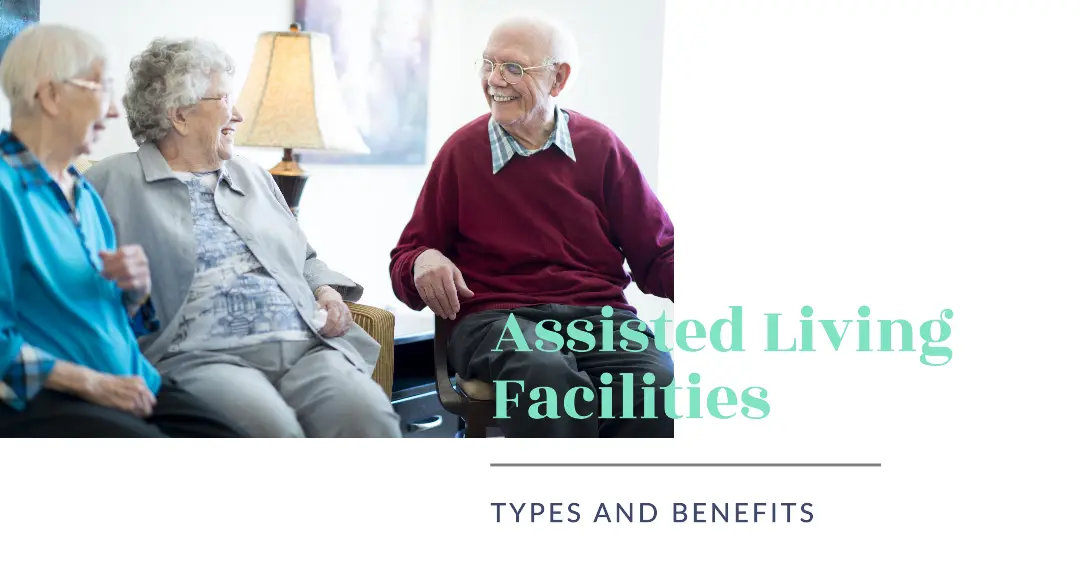Thinking about the future and how you’ll get the care you need as you age can feel overwhelming. It’s even more challenging when you’re not sure where to begin looking or what types of assisted living facilities are even available. But this is a conversation more and more families are having as the population ages in America. In fact, the United States Census Bureau found that by 2020, one in six Americans was over the age of 65, which accounts for almost 17% of the total population. Choosing the right kind of care, from independent living communities to nursing homes, can feel confusing, but understanding the differences between the types of assisted living facilities is an excellent place to start.
What are Types of Assisted Living Facilities?
While the term “assisted living” can encompass a variety of care options, in general, they are designed for those who can no longer live completely independently. They offer help with activities of daily living like bathing and dressing while providing varying degrees of medical support, social activities, and personal care services.
Let’s look more closely at the various types of assisted living communities to understand the different levels of care offered. Knowing your options will give you greater peace of mind as you think through this important decision.

Types of Assisted Living Facilities and Their Benefits
There are various types of senior living communities, from independent living to specialized memory care. Your choice ultimately depends on your or your loved one’s individual needs, preferences, and financial resources. Let’s look at the primary types of assisted living facilities, what they provide, and some of their benefits.
1. Independent Living
Independent living facilities are for older adults who don’t need help with everyday tasks but still enjoy the company of people their age in a community setting. Independent living communities don’t offer personal care or medical help, and the level of support they offer is minimal. Residents generally live in private apartments or cottages, with community dining and social activities.
Benefits of Independent Living:
- Socialization: Residents can engage with peers through organized activities, shared meals, and social gatherings.
- Maintenance-Free Living: Communities manage chores like housekeeping, landscaping, and home repairs, freeing residents to focus on leisure.
- Amenities: They typically offer a range of amenities such as fitness centers, libraries, swimming pools, and transportation services.
- Safety and Security: Emergency call systems, secure buildings, and a sense of community provide a secure living environment.
2. Assisted Living
Assisted living provides greater support than independent living but not as much medical support as you’d receive at a nursing home. Assisted living residences work well for those needing help with everyday tasks, such as getting dressed, taking a bath, or taking medication as prescribed by a doctor. The types of facilities vary, but generally, residents have their own private or shared apartments and access to common dining and social spaces. There is also a option for Assisted Living Short Term Stay.
Benefits of Assisted Living:
- Personalized Care: Care plans cater to the specific requirements of each resident, with assistance tailored to their individual needs. This may include medication management, help with dressing or bathing, or assistance with other daily tasks.
- Social Engagement and Activities: Structured activities are designed to combat social isolation, encourage connections among residents, and promote mental and physical well-being.
- Safety and Security: On-site staff, 24/7 emergency response systems, and secure environments offer peace of mind and immediate attention in case of unexpected events or health emergencies.
3. Nursing Homes
Nursing homes, or skilled nursing facilities, offer 24-hour medical care for individuals with chronic medical conditions that require ongoing attention from healthcare professionals. They deliver both short-term rehabilitation after hospitalization and long-term care for chronic health needs.
Benefits of Nursing Homes:
- Round-the-Clock Medical Care: Nursing homes have trained medical personnel to provide 24-hour supervision and care. They assist with essential medical tasks, manage medications, monitor vital signs, and provide personalized medical attention as needed.
- Specialized Care: Nursing homes offer specialized care services for seniors with complex health conditions like dementia, heart failure, or those recovering from surgeries. These facilities cater their expertise and resources to meet the unique requirements of residents needing this kind of ongoing support.
- Rehabilitation Services: Physical, occupational, and speech therapy sessions, for example, help residents regain lost function or improve their mobility and independence after surgeries, injuries, or illness.
4. Memory Care
Memory care communities specialize in the unique needs of seniors with Alzheimer’s or other types of dementia. These residences focus on providing a secure environment where residents can experience the best quality of life possible. In some cases, you’ll find that respite care is offered as well.
In fact, data from the National Center for Health Statistics indicated that 91% of dementia special care units provide residents with dementia-specific activities, while 90% have alarms on the doors to alert staff if a resident tries to leave. Some nursing homes have separate memory care units, although standalone communities also exist. But not every facility is equipped for the challenges of residents with dementia, so be sure you understand what a community does or does not provide as you think about the various types of assisted living facilities.
Fifty-eight percent of nursing home residents require specialized dementia care. This often includes medication support, memory-enhancing therapies, and activities that offer cognitive stimulation. These specialized environments ensure a supportive and safe atmosphere for seniors struggling with these types of cognitive impairments.
Want to know more? Check out our guide What to Expect from a Memory Care Facility
Benefits of Memory Care:
- Safe and Secure Environment: Secure facilities prevent residents prone to confusion or wandering from leaving the premises unsupervised, ensuring their well-being. Additionally, the specialized design reduces confusion and disorientation, making navigation easier and fostering a greater sense of familiarity.
- Specialized Staff: Trained professionals offer compassion and expertise in caring for individuals with dementia, offering residents the most supportive environment possible while helping them manage their challenging symptoms.
- Therapeutic Activities: Stimulating activities are created to maintain cognitive function, engage residents socially, and enhance overall well-being. Examples include art, music, reminiscence therapy, and gentle exercises adapted to the residents’ abilities.
What Is the Cost of the Different Types of Assisted Living Facilities?
It’s critical to think realistically about the costs when making this important decision. The amount you’ll pay will depend on what type of facility best suits your needs, as well as its geographical location and what it offers. Many times, a retirement community will offer different pricing tiers based on the level of care needed. Here is an estimated cost breakdown of the various types of assisted living facilities as of 2024:
| Type of Facility | Average Monthly Cost (US) |
|---|---|
| Independent Living | $1,200-$4,000 (or higher) |
| Assisted Living | $4,300 |
| Memory Care | $6,160 |
| Nursing Home (shared room) | $7,908 |
The pricing differences demonstrate that exploring the right living option for your situation, or that of your loved one, is vital.
It’s also essential to consider what these costs cover. Some communities offer an all-inclusive monthly fee while others have different levels depending on required care levels, and still others charge based on which individual services are required by each resident.
Paying for Assisted Living: What to Consider?
It is helpful to think about what your monthly cost includes. Typically meals, weekly housekeeping, transportation to scheduled activities, and basic utilities are standard at most assisted living residences, but costs will vary. Luxury independent living facilities often feature more elaborate amenities that come at a higher price, and costs also vary depending on whether you choose a private or shared room.
For example, the average monthly cost for assisted living is about $4,300. But keep in mind that some types of senior housing don’t provide skilled nursing services at all unless residents have private insurance coverage that provides it or they choose to pay out of pocket.
Assisted living services are usually covered through an HCBS waiver, while in-home care costs on average $26 per hour but those services typically aren’t covered by Medicare.
Medicare will, however, typically pay a portion of short-term skilled nursing care, but after 100 days the benefit stops. It’s also important to understand that although Medicare will pay for short-term stays in a skilled nursing facility, Medicare only pays if the patient is admitted to the hospital as an inpatient for at least three nights first.
It’s critical to consider how you plan to pay for assisted living facilities well ahead of time so that your finances are in order should the time come when you or a loved one requires more support. Many older adults find that their financial situation changes later in life, especially if they experience a major life event.
FAQs about Types of Assisted Living Facilities
What Is Assisted Living?
Assisted living is a senior living option ideal for older adults needing varying levels of personalized support, usually with everyday tasks, while remaining in a home-like environment. While specific services offered at different facilities vary, these communities usually provide help with tasks like dressing, bathing, managing medication, meal preparation, and social or recreational activities. It differs from nursing homes as it’s more focused on offering support with daily activities, rather than round-the-clock medical attention.
How Much do Assisted Living Facilities Cost?
Costs vary from around $1,000-$3,500 monthly for independent living and $4,300 per month on average for assisted living facilities in the US, to a significantly higher amount for nursing homes. Factors impacting cost include your location, amenities included, the type of facility, and the specific services needed. Thorough research is vital when comparing prices for different types of facilities and what’s included in each option.
What is the Difference Between Assisted Living and a Nursing Home?
Assisted living focuses more on aiding residents with their everyday lives by offering assistance with tasks like bathing and dressing. It’s for seniors who want to remain as independent as possible but need help with daily life tasks. Conversely, nursing homes offer round-the-clock medical care for individuals with acute or chronic health concerns, offering the highest level of support of any of the facilities.
Conclusion
Knowing your options regarding different types of assisted living facilities helps you prepare for the future with greater confidence and certainty. These residences allow individuals to enjoy an independent lifestyle in a safe, supportive environment, often enjoying social opportunities as well.
From the independence offered in retirement villages to specialized memory care facilities, a wide variety of care options meet a range of needs and budgets. If you find that you or an aging parent needs support in the coming months, I hope this overview is useful. Take the time now to do thorough research and understand your options regarding the many types of assisted living facilities. This proactive approach will make all the difference as you and your family consider this very personal and critical decision.




